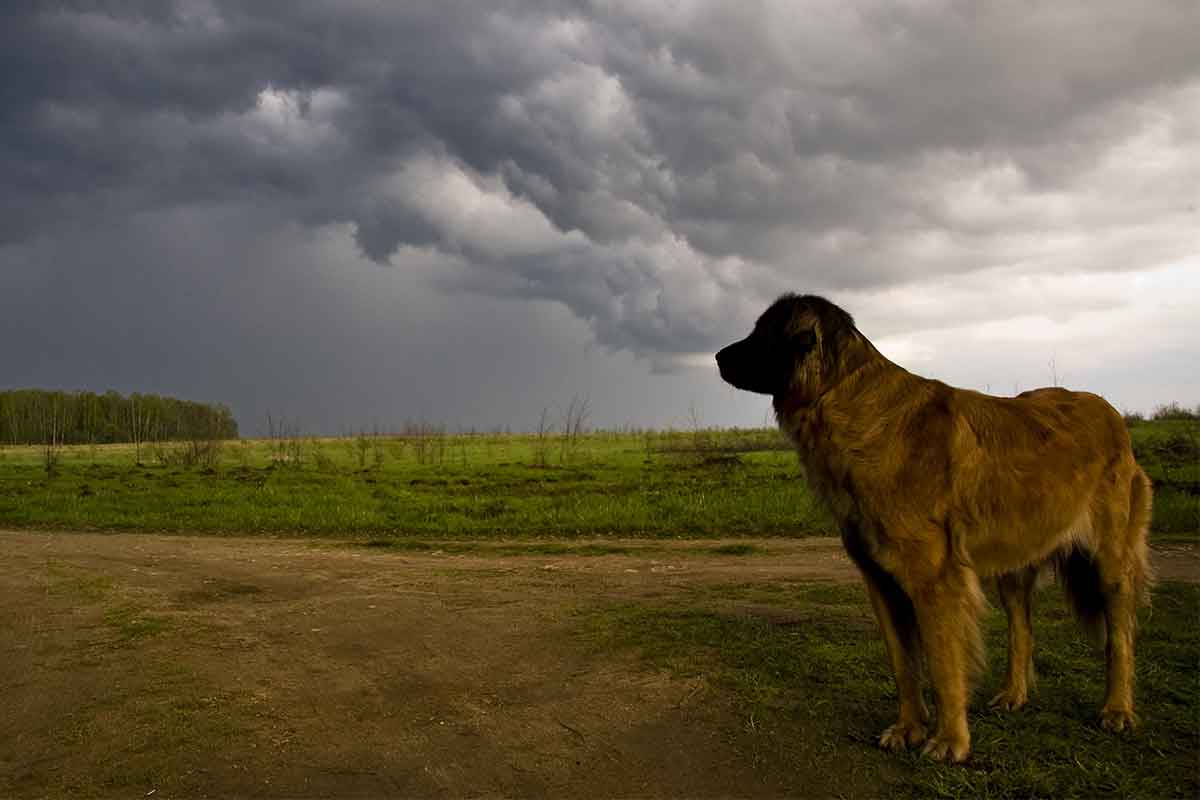Storm phobia is a problem not just because dogs are afraid. The physiological reaction to fear is bad enough—the racing heart, the rush of stress hormones—but fear also causes dogs to react in dangerous or destructive ways. They may destroy doors or jump through windows in an attempt to escape the frightening situation. By the time they start wrecking the house or harming themselves and owners take them to the veterinarian for help, the fear can be deep-seated and difficult to manage.
If your dog does not appear to be afraid of storms or shows only mild fear, you can take steps to reduce the likelihood that his fear will become worse. Here are some psychological and environmental management techniques to help dogs stay calm.
What To Do
First, don’t ignore your dog’s fear. It’s a myth that comforting your dog will reinforce his fear. Think how awful it would be if you were terribly afraid of something and friends or family told you to buck up or that it was all in your head. It doesn’t help, does it? There are better ways to help your dog than to pretend his fear isn’t real and expect him to just get over it.
Your reaction is important to your dog. Dogs read our body language, so if a storm makes you nervous, causing you to act differently than normal, your dog will notice and it may contribute to his own inability to stay calm. You can help him by projecting confidence and calm, says veterinary behaviorist Lisa Radosta, who practices at Florida Veterinary Behavior Service in West Palm Beach.
“Direct him in a way that is productive, like ‘Let’s go in this room. Let’s play tug. Let’s close the curtains.’ Do productive things.”
Associate the storm with good times, especially if you have a young dog who hasn’t yet developed a fear of storms or who exhibits only mild fear. Bring out a favorite toy, play tug or do some nose work, or give him a stuffed Kong or puzzle toy to work on.
“It is important not to reinforce the fearful behavior, but rather to distract the dog and reward less anxious behavior,” says Pamela Perry, DVM, a behavior resident at Cornell University College of Veterinary Medicine in Ithaca, New York.
Get Ahead Of The Storm
While it’s okay to comfort your dog if he seems afraid during a storm, Dr. Radosta says it’s important to recognize that soothing words from you aren’t going to give your dog a coping skill for future storms if you are away from home when they occur. To get around this, teach him that there’s a safe place he can go where good things always happen. Whether you call it a bunker, a safe space, or a sanctuary room, it will always be there for him.
Your dog may have a place where he likes to relax, such as his crate or the back of the closet, but if he doesn’t, you can choose one yourself. Good options include a table with a blanket thrown over it or a closet, bathroom or other area with no windows. The idea is to fashion a space where the dog can go if he’s scared and be less likely to hear or see the storm. Be sure to always leave the door to the room or crate open; your dog should never feel trapped in his safe space.
Every day, rain or shine, take him to his relaxation spot and give him a bone filled with peanut butter, a stuffed Kong, or some other long-lasting special treat. Turn on a white noise machine and let him enjoy his treat there on his own.
During a storm, if you’re home, take your dog to that space and give him his special treat. You should have some filled Kongs or peanut butter-stuffed bones in the freezer so they are ready to give any time a storm occurs. If you’re not home, he will still be able to go to that comforting spot on his own. Prepare the sanctuary room each day based on the weather forecast. Plug in a pheromone diffuser and turn on a white noise machine before you leave and place a special toy or treat there for him to find.
Most important, never punish your dog for being fearful, no matter how frustrated you are. That will make him more afraid. In the next post, we’ll address medication to help dogs cope with storm-related fears.
This article was reviewed/edited by board-certified veterinary behaviorist Dr. Kenneth Martin and/or veterinary technician specialist in behavior Debbie Martin, LVT.








